
The Agaricaceae are a family of basidiomycete fungi and include the genus Agaricus, as well as basidiomycetes previously classified in the families Tulostomataceae, Lepiotaceae, and Lycoperdaceae.

Limacella is a genus of mushroom-forming fungi in the family Amanitaceae in order Agaricales. Some of the species have been classified as members of genus Lepiota. Limacella was described by mycologist Franklin Sumner Earle in 1909.
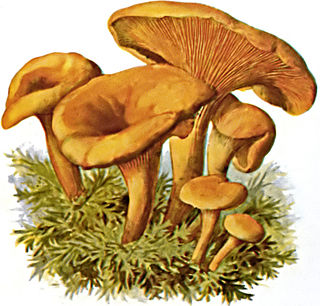
The Hygrophoropsidaceae are a family of mushrooms that are gilled in appearance but lie within the Boletales. The family contains 18 species within two genera: Leucogyrophana and Hygrophoropsis, with the best-known member being the "false chanterelle", Hygrophoropsis aurantiaca. Hygrophoropsidaceae was circumscribed by French mycologist Robert Kühner in 1980, with Hygrophoropsis as the type genus. Unlike most members of the Boletales, Hygrophoropsidaceae species are saprophytic wood-rotting fungi that cause brown rot in their hosts. The genera Austropaxillus and Tapinella, once placed in this family, are now classified in the Serpulaceae and Tapinellaceae, respectively.
Puccinia angustata is a plant pathogen that causes rust on plants in the genus Monarda. It was first described scientifically in 1873 by American mycologist Charles Horton Peck, who found it growing on the leaves on the sedges Scirpus sylvaticum and S. eriophorum.

Auriporia is a small genus of four species of poroid fungi in the family Fomitopsidaceae.

The Physalacriaceae are a family of fungi in the order Agaricales. Species in the family have a widespread distribution, ranging from the Arctic, (Rhizomarasmius), to the tropics, e.g. Gloiocephala, and from marine sites (Mycaureola) and fresh waters (Gloiocephala) to semiarid forests (Xerula).
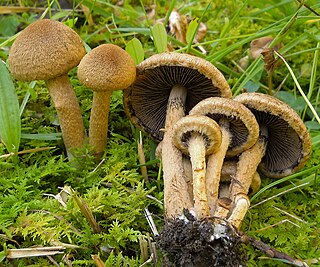
Lacrymaria is a genus of fungi in the family Psathyrellaceae. A 2008 estimate placed 14 species in the widespread genus.
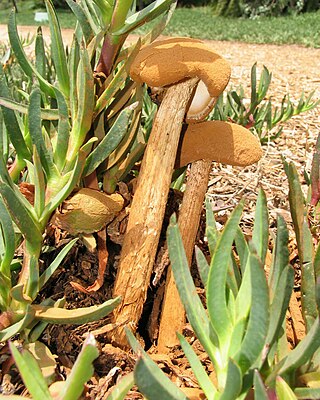
Battarrea is a genus of mushroom-producing fungi. The genus used to be classified in the family Tulostomaceae until molecular phylogenetics revealed its affinity to the Agaricaceae. Species of Battarrea have a peridium that rests atop an elongated, hollow stipe with a surface that tends to become torn into fibrous scales. Inside the peridium, the gleba consists of spherical, warted spores, and a capillitium of simple or branched hyphal threads that have spiral or angular thickenings. The genus is named after Italian priest and naturalist Giovanni Antonio Battarra.

Hygrophoropsis is a genus of gilled fungi in the family Hygrophoropsidaceae. It was circumscribed in 1888 to contain the type species, H. aurantiaca, a widespread fungus that, based on its appearance, has been affiliated with Cantharellus, Clitocybe, and Paxillus. Modern molecular phylogenetic analysis shows that the genus belongs to the suborder Coniophorineae of the order Boletales.

Disciseda is a genus of gasteroid fungi in the family Agaricaceae. It is a widely distributed genus that is prevalent in arid zones. Disciseda was circumscribed by mycologist Vassiliĭ Matveievitch Czernajew in 1845.
Secotium is a genus of fungi in the family Agaricaceae. The members of this genus are closely related to ordinary Agaricus mushrooms, but do not open out in the usual way; this has given rise to the term "secotioid" for such mushrooms in general. They are thought to form an evolutionary link between agarics and gasteroid fungi. Secotium is a widespread genus, with species that are predominantly found in warm and arid regions.
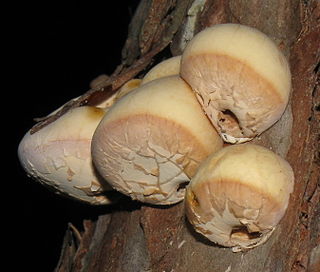
Cryptoporus is a genus of fungi in the family Polyporaceae. Originally described as a section of Polyporus by Charles Horton Peck in 1880, Cornelius Lott Shear made it a distinct genus in 1902. Cryptoporus contains two species, C. sinensis and the type C. volvatus, found in southeast Asia and North America, respectively. C. sinensis is morphologically indistinguishable from C. volvatus except for its smaller spores (7.5–10 by 4–5 μm compared to 10–12.5 by 5–6 μm. The generic name combines the Ancient Greek words κρυπτός and πόρος.

Skeletocutis is a genus of about 40 species of poroid fungi in the family Polyporaceae. The genus has a cosmopolitan distribution, although most species are found in the Northern Hemisphere. It causes a white rot in a diverse array of woody substrates, and the fruit bodies grow as a crust on the surface of the decaying wood. Sometimes the edges of the crust are turned outward to form rudimentary bracket-like caps.

Clavaria is a genus of fungi in the family Clavariaceae. Species of Clavaria produce basidiocarps that are either cylindrical to club-shaped or branched and coral-like. They are often grouped with similar-looking species from other genera, when they are collectively known as the clavarioid fungi. All Clavaria species are terrestrial and most are believed to be saprotrophic. In Europe, they are typical of old, mossy, unimproved grassland. In North America and elsewhere, they are more commonly found in woodlands.
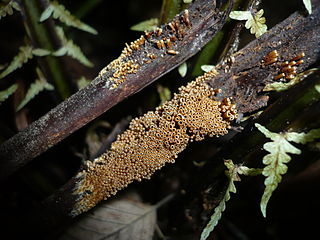
Woldmaria is a fungal genus in the family Niaceae. The genus is monotypic, containing the single species Woldmaria filicina, found in Europe and North America. Woldmaria was described by William Bridge Cooke in 1961, with Woldmaria crocea as the type species; it was subsequently moved into synonymy with W. filicina.
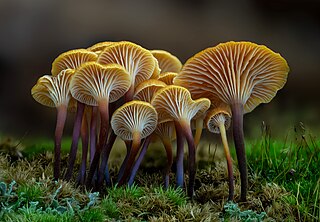
Xeromphalina is a genus of fungi in the family Mycenaceae. The genus has a widespread distribution, and contains about 30 species.
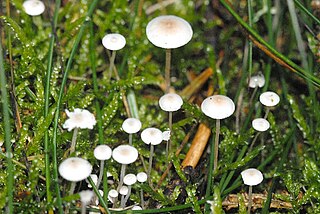
Hemimycena is a genus of fungi in the family Mycenaceae. The genus has a widespread distribution, and according to a 2008 estimate, contains about 50 species. The genus was described by mycologist Rolf Singer in 1938. They lack amyloid reaction in the spores.
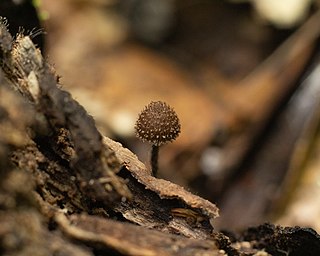
Cystoagaricus is a genus of fungi in the family Psathyrellaceae. The genus contains four species found in subtropical America. The genus was circumscribed by mycologist Rolf Singer in 1947, with Cystoagaricus strobilomyces as the type species.

Aureoboletus auriporus is a species of bolete fungus in the family Boletaceae that is found in Europe and North America. It was originally described in 1872 by American mycologist Charles Horton Peck, who called it Boletus auriporus. Zdenek Pouzar transferred it to the genus Aureoboletus in 1957.
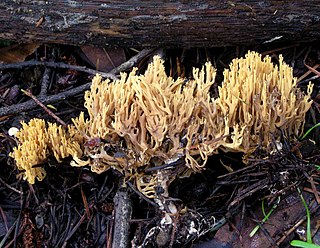
Ramaria myceliosa is a species of coral fungus in the family Gomphaceae. Found in North America, it was originally described by Charles Horton Peck in 1904 with the name Clavaria myceliosa. The type was collected by botanist Edwin Bingham Copeland in the mountains near Stanford University in California. E.J.H. Corner transferred it to the genus Ramaria in 1950. Giachini and colleagues proposed that Ramaria myceliosa is the same species as the European Phaeoclavulina curta, but did not provide molecular evidence to support their suggested synonymy. In a recent (2014) publication on California fungi, the authors propose the transfer of Ramaria myceliosa to the genus Phaeoclavulina, but as of January 2016, this transfer has not been accepted by either MycoBank or Index Fungorum.


















